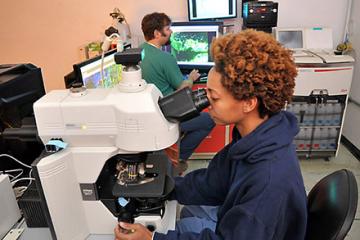Taking on Emerging Animal Diseases at the Source

In efforts to develop an effective vaccine against African swine fever virus (ASFV), graduate student Erin Howey (foreground) performs immunofluorescent screening of porcine tissues for ASFV with veterinary medical officer Jonathan Arzt. (Photo by Kathleen Apicelli)
An old adage states that the best defense is a good offense. The Agricultural Research Service (ARS) is taking that to heart, by working with scientists abroad to address emerging animal disease threats there before they can take hold in America.
ARS has established strategic research collaborations worldwide dedicated to “offshore” research. This collaboration specifically targets research that cannot be conducted in the United States, either because a disease does not exist here or the expertise in a pathogen resides overseas.
Of particular concern are emerging zoonotic pathogens – those that may spread from animals to infect humans.
“Often, the emergence of these new animal pathogens occurs in ‘hot spots,’ where events that intersect wildlife and animal agriculture promote the transmission of pathogens to new animal hosts, and in the case of zoonotic pathogens, humans,” said Dr. Cyril Gay, ARS national program leader for animal production and protection.
“The impact of emerging pathogens can be quite substantial, as shown by the spread of pathogens like highly pathogenic avian influenza, African swine fever, and SARS-CoV-2 (the root cause of COVID-19) around the world,” Gay said. “Key challenges associated with the emergence of new pathogens are the ability to detect them and the availability of medical countermeasures to prevent and control their spread between animals and humans.”
According to Gay, the economic loss caused by disease outbreaks varies depending upon the size of the affected segment of agriculture, how quickly the pathogen can be controlled and eradicated, and whether public health is a factor. For instance, the estimated cost of the ongoing avian influenza outbreak is $661 million, whereas it’s about $14 trillion in the case of COVID-19.
The ARS plan for the research and development of veterinary medical countermeasures uses three principles: diagnostic tests for disease surveillance and early detection; biosecurity to protect farms; and vaccines for disease prevention and to prevent the spread of the new pathogen within and beyond an infected farm.
“The discovery and development of these medical countermeasures in response to a new and emerging disease outbreak requires rapid, real-time research and collaborations across the agencies of the U.S. government,” Gay said. “This was clearly demonstrated with the implementation of the President’s National Biodefense Strategy and Implementation Plan during the COVID pandemic.”
For new and emerging animal pathogens, ARS plays a leading role within the federal government for developing veterinary medical countermeasures. This involvement requires active research programs in diagnostic and vaccine discovery, and the ability to rapidly develop and transfer fit-for-purpose medical countermeasures to the veterinary biologics industry.
No one knows which new pathogen may be the cause of the next disease outbreak, so ARS has developed a biodefense research program that focuses on pathogens that are known to be especially dangerous and are the most likely to cause the emergence of new pathogens. The list is large and includes highly pathogenic avian influenza, African swine fever, Japanese encephalitis, and emerging coronaviruses such as SARS-CoV-2.
“I think we’re going in the right direction, but we need to continue to work strategically and align resources and expertise to maximize the use of limited resources around the globe,” Gay said. “Recent examples include the establishment of global alliances for especially dangerous transboundary animal pathogens such as the Global African Swine Fever Research Alliance (GARA) and the Global Foot-and-Mouth Disease Research Alliance (GFRA); both have provided invaluable expertise and resources in our effort to implement highly effective and relevant research programs.” – by Scott Elliott, ARS Office of Communications
Also in our series on exotic animal diseases:

